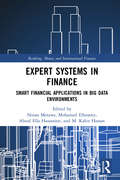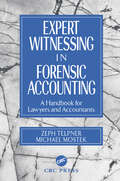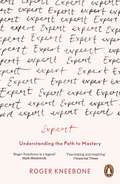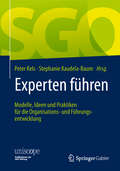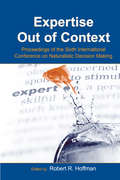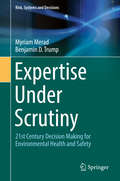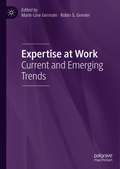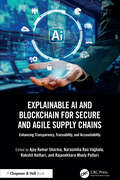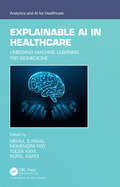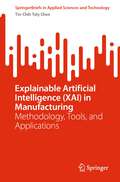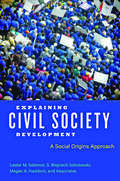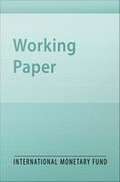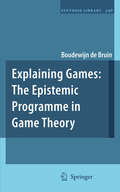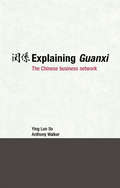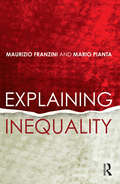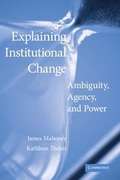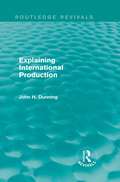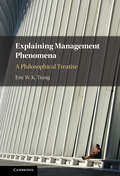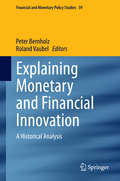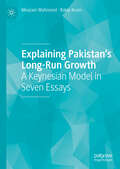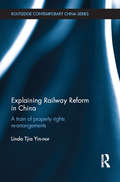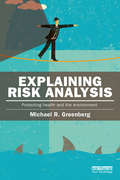- Table View
- List View
Expert Systems in Finance: Smart Financial Applications in Big Data Environments (Banking, Money and International Finance)
by Aboul Ella Hassanien Mohamed Elhoseny M. Kabir Hassan Noura MetawaThroughout the industry, financial institutions seek to eliminate cumbersome authentication methods, such as PINs, passwords, and security questions, as these antiquated tactics prove increasingly weak. Thus, many organizations now aim to implement emerging technologies in an effort to validate identities with greater certainty. The near instantaneous nature of online banking, purchases, transactions, and payments puts tremendous pressure on banks to secure their operations and procedures. In order to reduce the risk of human error in financial domains, expert systems are seen to offer a great advantage in big data environments. Besides their efficiency in quantitative analysis such as profitability, banking management, and strategic financial planning, expert systems have successfully treated qualitative issues including financial analysis, investment advisories, and knowledge-based decision support systems. Due to the increase in financial applications’ size, complexity, and number of components, it is no longer practical to anticipate and model all possible interactions and data processing in these applications using the traditional data processing model. The emergence of new research areas is clear evidence of the rise of new demands and requirements of modern real-life applications to be more intelligent. This book provides an exhaustive review of the roles of expert systems within the financial sector, with particular reference to big data environments. In addition, it offers a collection of high-quality research that addresses broad challenges in both theoretical and application aspects of intelligent and expert systems in finance. The book serves to aid the continued efforts of the application of intelligent systems that respond to the problem of big data processing in a smart banking and financial environment.
Expert Witnessing in Forensic Accounting: A Handbook for Lawyers and Accountants (Expert Witnessing)
by Zeph Telpner Michael MostekFrom opposing the local CPA to tackling the Big Five - Everything you need to know about accounting in the courtroomWith the recent boom in litigation and malpractice charges concerning tax, accounting, financial litigation, and fraud disputes, more and more accounting professionals are being hired as expert witnesses. Yet, few lawyers have
Expert de telemarketing: Como conseguir rapidamente vários encontros para vendas
by Bernard Levine Daniel Victor Cavalcante GamaSe você está querendo encher a sua agenda com vários encontros e reuniões para vendas, este livro único irá trazer para você resultados garantidos!
Expert en Telemarketing, Comment obtenir rapidement des rendez-vous commerciaux
by Bernard Levine Houndegla OndineSi vous vouliez remplir votre agenda avec plusieurs rendez-vous commerciaux, ce livre unique vous apportera des solutions rapides.
Expert: Understanding the Path to Mastery
by Roger Kneebone'Roger Kneebone is a legend' Mark Miodownik, author of Stuff Matters'Fascinating and inspiring' Financial Times'The pandemic has made the necessity of relying on experts evident to all . . . this is a rich exploration of lifelong learning' GuardianWhat could a lacemaker have in common with vascular surgeons? A Savile Row tailor with molecular scientists? A fighter pilot with jazz musicians? At first glance, very little. But Roger Kneebone is the expert on experts, having spent a lifetime finding the connections.In Expert, he combines his own experiences as a doctor with insights from extraordinary people and cutting-edge research to map out the path we're all following - from 'doing time' as an Apprentice, to developing your 'voice' and taking on responsibility as a Journeyman, to finally becoming a Master and passing on your skills. As Kneebone shows, although each outcome is different, the journey is always the same. Whether you're developing a new career, studying a language, learning a musical instrument or simply becoming the person you want to be, this ground-breaking book reveals the path to mastery.
Experten führen: Modelle, Ideen und Praktiken für die Organisations- und Führungsentwicklung (uniscope. Publikationen der SGO Stiftung)
by Stephanie Kaudela-Baum Peter KelsDer Herausgeberband behandelt die Frage, wie sich Spezialisten und Experten in wissensintensiven Organisationen in Anbetracht von Herausforderungen wie Multirationalität, Digitalisierung, Ökonomisierung oder Wertewandel wirkungsvoll führen lassen. Das Fachbuch zeichnet ein differenziertes und vielschichtiges Bild aktueller Führungsherausforderungen und Führungsansätze in Expertenorganisationen, wie Bildungsinstitutionen, Gesundheitsorganisationen, Beratungs- und Dienstleistungsunternehmen oder öffentlicher Verwaltung. Die Autoren beleuchten grundlegende Dimensionen einer gelingenden Führung und zeigen Möglichkeiten zur Gestaltung der Organisations- und Führungsentwicklung praxisnah auf.Die Herausgeber entwickeln vor dem Hintergrund der Gastbeiträge, eigener Forschung sowie des heutigen Wissensstands ein integrales Modell, welches die zentralen Ebenen und Ansatzpunkte zur produktiven Gestaltung von Führungsbeziehungen zwischen Managern, Führungskräften und Experten aufzeigt.Die Stiftung der Schweizerischen Gesellschaft für Organisation und Management SGO unterstützte die dieser Publikation zugrunde liegende Studie.
Expertise Out of Context: Proceedings of the Sixth International Conference on Naturalistic Decision Making (Expertise: Research And Applications Ser.)
by Robert R. HoffmanResearchers have revealed that real expertise, while applied to well-defined tasks with highly circumscribed contexts, often stretches beyond its routine boundaries. For example, a medical doctor may be called upon to diagnose a rare disease or perform emergency surgery outside his or her area of specialization because other experts are not availab
Expertise Under Scrutiny: 21st Century Decision Making for Environmental Health and Safety (Risk, Systems and Decisions)
by Benjamin D. Trump Myriam MeradThis book explores the challenges that confront leaders in government and industry when making decisions in the areas of environmental health and safety. Today, decision making demands transparency, robustness, and resiliency. However thoughtfully they are devised, decisions made by governments and enterprises can often trigger immediate, passionate public response.Expertise Under Scrutiny shows how leaders can establish organizational decision making processes that yield valid, workable choices even in fast-changing and uncertain conditions.The first part of the book examines the organizational decision making process, describing the often-contentious environment in which important environmental health and safety decisions are made, and received. The authors review the roles of actors and experts in the decision making process. The book goes on to address such topics as:· The roles of actors and experts in the decision making process· Ethics and analytics as drivers of good decisions· Why managing problems in safety, security, environment, and health Part II offers an outline for adopting a formal decision support structure, including the use of decision support tools. It includes a chapter devoted to ELECTRE (ELimination and Choice Expressing Reality), a multi-criteria decision analysis system.The book concludes with an insightful appraisal and analysis of the expertise, structure and resources needed for navigating well-supported, risk-informed decisions in our 21st Century world.Expertise Under Scrutiny benefits a broad audience of students, academics, researchers, and working professionals in management and related disciplines, especially in the field of environmental health and safety.
Expertise at Work: Current and Emerging Trends
by Marie-Line Germain Robin S. GrenierExpertise, which combines knowledge, years of experience in one domain, problem-solving skills, and behavioral traits, is a valuable resource for organizations. To understand the diverse picture of expertise in the workplace, this book offers scholars and scholar-practitioners a comprehensive assessment of the development of human expertise in organizations. Using contemporary perspectives across a broad range of domains, contributors offer readers various professional perspectives including veterans, education, sports, and information technology. The book also describes how researchers and practitioners can address practical problems related to the development, redevelopment, and sustainability of expertise. Finally, the book puts specific emphasis on the emerging trends in the study and practice of expertise in organizations, including the use of artificial intelligence.
Explainable AI and Blockchain for Secure and Agile Supply Chains: Enhancing Transparency, Traceability, and Accountability
by Narasimha Rao Vajjhala Rajasekhara Mouly Potluri Ajay Kumar Sharma Rakshit KothariThis book examines the transformative potential of integrating explainable artificial intelligence (XAI) and blockchain technology in modern supply chain management.It explores how these innovative technologies address pressing challenges such as data transparency, traceability, fraud prevention, and operational efficiency in complex global supply chains. With detailed analyses, case studies, and real-world applications, these chapters provide insights into leveraging XAI to demystify AI decision-making and blockchain, ensuring data security and decentralized accountability. Key topics include sustainable practices, smart contract automation, and human-centric approaches to enhancing trust and collaboration among stakeholders.This comprehensive volume serves as a valuable resource for academics, industry leaders, and policymakers seeking to harness cutting-edge technologies for building resilient and transparent supply chains.
Explainable AI in Healthcare: Unboxing Machine Learning for Biomedicine (Analytics and AI for Healthcare)
by Mehul S Raval Mohendra Roy Tolga Kaya Rupal KapdiThis book combines technology and the medical domain. It covers advances in computer vision (CV) and machine learning (ML) that facilitate automation in diagnostics and therapeutic and preventive health care. The special focus on eXplainable Artificial Intelligence (XAI) uncovers the black box of ML and bridges the semantic gap between the technologists and the medical fraternity. Explainable AI in Healthcare: Unboxing Machine Learning for Biomedicine intends to be a premier reference for practitioners, researchers, and students at basic, intermediary levels and expert levels in computer science, electronics and communications, information technology, instrumentation and control, and electrical engineering. This book will benefit readers in the following ways: Explores state of art in computer vision and deep learning in tandem to develop autonomous or semi-autonomous algorithms for diagnosis in health care Investigates bridges between computer scientists and physicians being built with XAI Focuses on how data analysis provides the rationale to deal with the challenges of healthcare and making decision-making more transparent Initiates discussions on human-AI relationships in health care Unites learning for privacy preservation in health care
Explainable Artificial Intelligence: Methodology, Tools, and Applications (SpringerBriefs in Applied Sciences and Technology)
by Tin-Chih Toly ChenThis book provides a comprehensive overview of the latest developments in Explainable AI (XAI) and its applications in manufacturing. It covers the various methods, tools, and technologies that are being used to make AI more understandable and communicable for factory workers. With the increasing use of AI in manufacturing, there is a growing need to address the limitations of advanced AI methods that are difficult to understand or explain to those without a background in AI. This book addresses this need by providing a systematic review of the latest research and advancements in XAI specifically tailored for the manufacturing industry.The book includes real-world case studies and examples to illustrate the practical applications of XAI in manufacturing. It is a valuable resource for researchers, engineers, and practitioners working in the field of AI and manufacturing.
Explaining Civil Society Development: A Social Origins Approach
by Lester M. Salamon S. Wojciech Sokolowski Megan A. HaddockHow historically rooted power dynamics have shaped the evolution of civil society globally.The civil society sector—made up of millions of nonprofit organizations, associations, charitable institutions, and the volunteers and resources they mobilize—has long been the invisible subcontinent on the landscape of contemporary society. For the past twenty years, however, scholars under the umbrella of the Johns Hopkins Comparative Nonprofit Sector Project have worked with statisticians to assemble the first comprehensive, empirical picture of the size, structure, financing, and role of this increasingly important part of modern life. What accounts for the enormous cross-national variations in the size and contours of the civil society sector around the world? Drawing on the project’s data, Lester M. Salamon, S. Wojciech Sokolowski, Megan A. Haddock, and their colleagues raise serious questions about the ability of the field’s currently dominant preference and sentiment theories to account for these variations in civil society development. Instead, using statistical and comparative historical materials, the authors posit a novel social origins theory that roots the variations in civil society strength and composition in the relative power of different social groupings and institutions during the transition to modernity. Drawing on the work of Barrington Moore, Dietrich Rueschemeyer, and others, Explaining Civil Society Development provides insight into the nonprofit sector’s ability to thrive and perform its distinctive roles. Combining solid data and analytical clarity, this pioneering volume offers a critically needed lens for viewing the evolution of civil society and the nonprofit sector throughout the world.
Explaining Episodes of Growth Accelerations, Decelerations, and Collapses in Western Africa
by Patrick Imam Gonzalo SalinasA report from the International Monetary Fund.
Explaining Games
by Boudewijn De BruinDoes game theory - the mathematical theory of strategic interaction - provide genuine explanations of human behaviour? Can game theory be used in economic consultancy or other normative contexts? Explaining Games: The Epistemic Programme in Game Theory - the first monograph on the philosophy of game theory - is a bold attempt to combine insights from epistemic logic and the philosophy of science to investigate the applicability of game theory in such fields as economics, philosophy and strategic consultancy. De Bruin proves new mathematical theorems about the beliefs, desires and rationality principles of individual human beings, and he explores in detail the logical form of game theory as it is used in explanatory and normative contexts. He argues that game theory reduces to rational choice theory if used as an explanatory device, and that game theory is nonsensical if used as a normative device. A provocative account of the history of game theory reveals that this is not bad news for all of game theory, though. Two central research programmes in game theory tried to find the ultimate characterisation of strategic interaction between rational agents. Yet, while the Nash Equilibrium Refinement Programme has done badly thanks to such research habits as overmathematisation, model-tinkering and introversion, the Epistemic Programme, De Bruin argues, has been rather successful in achieving this aim.
Explaining Guanxi: The Chinese Business Network
by Anthony Walker Ying Lun SoGuanxi, a system of Chinese business relationships, is often described, but is rarely fully understood. Though it seems intangible, there is no doubt that it has contributed significantly to the success of Chinese entrepreneurs and the places where they work. Translated loosely as ‘personal ties’, this simple explanation belies a complex and nuanced system. Guanxi has often been criticised as nepotism - unfair, inefficient, even corrupt, and generally detrimental to business and economic growth… but if it is that bad, how does it survive? This insightful book unravels the origins of Guanxi and provides a much-needed explanation of the phenomena. It investigates: why it was initiated and developed what function it serves how it is maintained why it is such a dominant phenomenon in Chinese business life Combining economics, law and culture, this clear and concise book looks to the future of Guanxi based on its history. Drawing on cultural, organizational and economic studies, it takes a multi-disciplinary approach, integrating these various topics into a coherent explanation of Guanxi ensuring that this illuminating book will be equally useful to students of Asian business as to practitioners working within this market.
Explaining Inequality
by Maurizio Franzini Mario PiantaInequalities in incomes and wealth have increased in advanced countries, making our economies less dynamic, our societies more unjust and our political processes less democratic. As a result, reducing inequalities is now a major economic, social and political challenge. This book provides a concise yet comprehensive overview of the economics of inequality. Until recently economic inequality has been the object of limited research efforts, attracting only modest attention in the political arena; despite important advances in the knowledge of its dimensions, a convincing understanding of the mechanisms at its roots is still lacking. This book summarizes the topic and provides an interpretation of the mechanisms responsible for increased disparities. Building on this analysis the book argues for an integrated set of policies addressing the roots of inequalities in incomes and wealth Explaining Inequality will be of interest to students, researchers and practitioners concerned with inequality, economic and public policy and political economy.
Explaining Institutional Change: Ambiguity, Agency, and Power
by James Mahoney Kathleen ThelenThis book contributes to emerging debates in political science and sociology on institutional change. Its introductory essay proposes a new framework for analyzing incremental change that is grounded in a power-distributional view of institutions and that emphasizes ongoing struggles within but also over prevailing institutional arrangements. Five empirical essays then bring the general theory to life by evaluating its causal propositions in the context of sustained analyses of specific instances of incremental change. These essays range widely across substantive topics and across times and places, including cases from the United States, Africa, Latin America, and Asia. The book closes with a chapter reflecting on the possibilities for productive exchange in the analysis of change among scholars associated with different theoretical approaches to institutions.
Explaining International Production (Routledge Revivals)
by John H. DunningJohn Dunning’s general theory of international production, first propounded in the late 1970’s, has generated considerable debate. This work thoughtfully reassesses the paradigm, and extends the analysis to embrace issues of theoretical and empirical importance. In a collection of essays, the changing characteristics of international production are examined, and an interdisciplinary approach suggested for understanding the multinational enterprise in the world economy. This book, first published in 1988, will be of value not only to economists and international business analysts, but to scholars in other fields, notably organizational, marketing and management specialists.
Explaining Long-Term Trends in Health and Longevity
by Robert W. FogelExplaining Long-Term Trends in Health and Longevity is a collection of essays by Nobel laureate Robert W. Fogel on the theory and measurement of aging and health-related variables. Dr. Fogel analyzes historic data on height, health, nutrition, and life expectation to provide a clearer understanding of the past, illustrate the costs and benefits of using such measures, and note the difficulties of drawing conclusions from data intended for different purposes. Dr. Fogel explains how the basic findings of the anthropometric approach to historical analysis have helped reinterpret the nature of economic growth. Rising life expectancies and lower disease rates in countries experiencing economic growth highlight the importance of improving nutrition and agricultural productivity.
Explaining Management Phenomena: A Philosophical Treatise
by Eric W. TsangOne key objective of management research is to explain business phenomena. Yet understanding the nature of explanation is essentially a topic in philosophy. This is the first book that bridges the gap between a technical, philosophical treatment of the topic and the more practical needs of management scholars, as well as others across the social sciences. It explores how management phenomena can be explained from a philosophical perspective, and renders sophisticated philosophical arguments understandable by readers without specialized training. Covering virtually all the major aspects of the nature of explanation, this work will enhance empirical and theoretical research, as well as approaches combining the two. With many examples from management literature and business news, this study helps scholars in those fields to improve their research outcomes.
Explaining Monetary and Financial Innovation
by Peter Bernholz Roland VaubelThis book discusses theories of monetary and financial innovation and applies them to key monetary and financial innovations in history - starting with the use of silver bars in Mesopotamia and ending with the emergence of the Eurodollar market in London. The key monetary innovations are coinage (Asia minor, China, India), the payment of interest on loans, the bill of exchange and deposit banking (Venice, Antwerp, Amsterdam, London). The main financial innovation is the emergence of bond markets (also starting in Venice). Episodes of innovation are contrasted with relatively stagnant environments (the Persian Empire, the Roman Empire, the Spanish Empire). The comparisons suggest that small, open and competing jurisdictions have been more innovative than large empires - as has been suggested by David Hume in 1742.
Explaining Pakistan’s Long-Run Growth: A Keynesian Model in Seven Essays
by Moazam Mahmood Rabia IkramThis book explains the behaviour of output and its growth over time. It does so by deliberating over a choice among three fundamental models—the Samuelson-Swan-Solow neoclassical model, the Harrod-Domar model and the Keynesian model—to choose one fit for purpose. The criteria for goodness of fit are some mathematical properties of growth models. The model chosen for meeting these properties is the Keynesian model, which is a bit better on all these counts. The chosen Keynesian model of aggregate demand has been used to explain the observed behaviour of Pakistan’s long-run growth of gross domestic product (GDP). Pakistan’s GDP growth over the long run between 1973 and 2019 is marked by a statistically significant hiatus at approximately 1992. Pre-1992, GDP growth on trend approximated 6 percent per annum. Post-1992, it drops on trend to approximately 4 percent per annum. Applied to the hiatus in Pakistan’s GDP growth after 1992, this model shows that pre-1992, high GDP growth is explained by high investment growth, paired with a low marginal propensity to consume (MPC), while post-1992, lowered GDP growth is explained by lower investment growth paired with a higher MPC. Thus, Pakistan’s higher GDP growth pre-1992 was investment-led while its lower GDP growth post-1992 has been consumption-led. The book then traces the causality of these trends in investment and consumption to a falling trend in public investment. This is linked to an increasingly austere regulatory policy environment, while private investment fails to step in and maintain aggregate investment.
Explaining Railway Reform in China: A Train of Property Rights Re-arrangements (Routledge Contemporary China Series)
by Linda Tjia Yin-norHaving been state-owned for decades, the railway reform in China confused many people, particularly in terms of its ownership and property rights arrangements. Western literature always prescribes that the best model for railway reform is privatization. China’s leadership has also enunciated the state’s determination to re-arrange property rights and rejuvenate corporate governance. But is China’s railway reform really a story of convergence and will the Chinese government follow the western model of railway reform? Addressing these questions, this book provides a positive explanation of the reform in China’s railway sector between 1978 and the dissolution of the Ministry of Railways. It bridges the socialist reform and transport policy literature, and studies the empirical changes of the property rights arrangements in China’s railway system. Refuting the convergence theory, it concludes that the cyclical reform policies of decentralization and re-centralization were actually an exploratory and interactive mechanism of "assets discovery" and "assets recovery". This in-depth study is based on 21 face-to-face interviews with railway cadres as well as field trips to collect first-hand information in Guangzhou, Beijing, Shanghai, Tianjin and Wuhan. As one of the only empirical studies on the reform of the railway sector in China, this book will be of interest to students and scholars of China studies, Transport studies and Political Economy.
Explaining Risk Analysis: Protecting health and the environment (Earthscan Risk in Society)
by Michael R GreenbergRisk analysis is not a narrowly defined set of applications. Rather, it is widely used to assess and manage a plethora of hazards that threaten dire implications. However, too few people actually understand what risk analysis can help us accomplish and, even among experts, knowledge is often limited to one or two applications. Explaining Risk Analysis frames risk analysis as a holistic planning process aimed at making better risk-informed decisions and emphasizing the connections between the parts. This framework requires an understanding of basic terms, including explanations of why there is no universal agreement about what risk means, much less risk assessment, risk management and risk analysis. Drawing on a wide range of case studies, the book illustrates the ways in which risk analysis can help lead to better decisions in a variety of scenarios, including the destruction of chemical weapons, management of nuclear waste and the response to passenger rail threats. The book demonstrates how the risk analysis process and the data, models and processes used in risk analysis will clarify, rather than obfuscate, decision-makers’ options. This book will be of great interest to students and scholars of risk assessment, risk management, public health, environmental science, environmental economics and environmental psychology.
